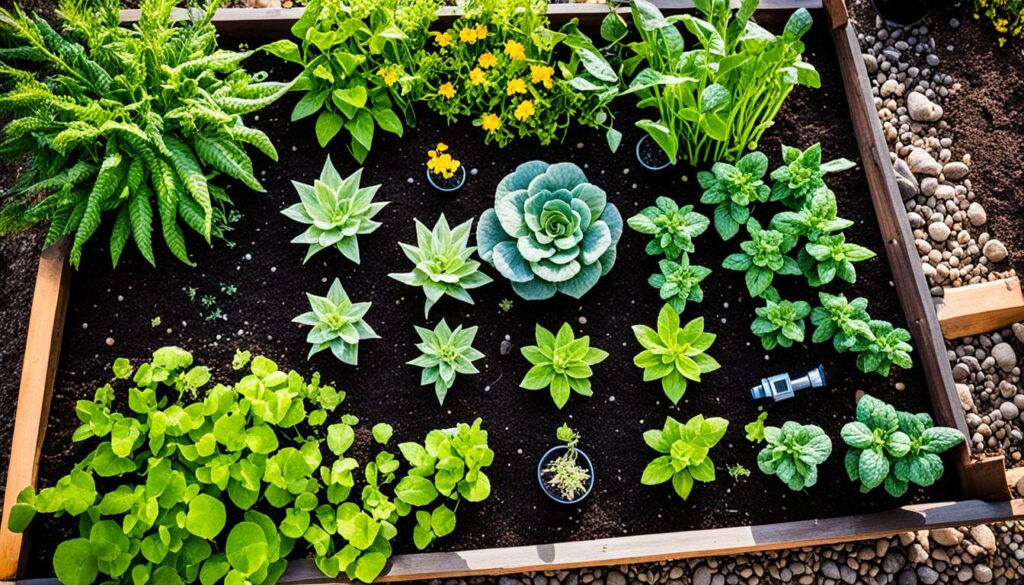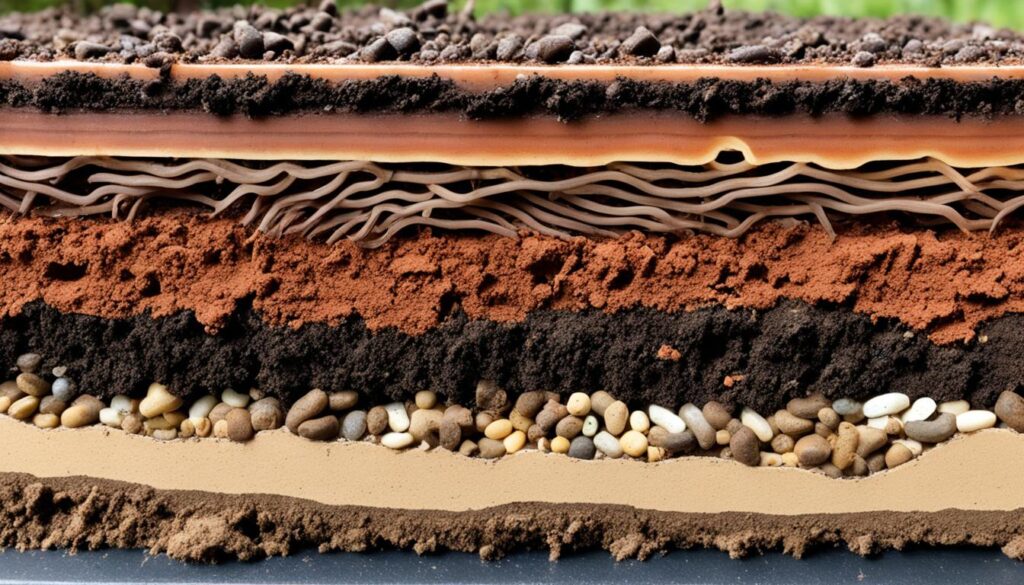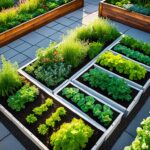Raised Bed Gardening: The Ultimate Guide
Do you dream of a garden that’s easy to care for and full of fresh veggies? Have you thought about the benefits of raised bed gardening? This method brings many advantages, like longer growing seasons, better soil, and fewer pests. In this guide, we’ll show you how to make a raised bed garden that turns your yard into a lush, productive spot.
Key Takeaways
- Raised bed gardening gives you a longer growing season and better soil than traditional gardens.
- It makes gardening easier and more comfortable by providing easy access.
- These gardens can fit any space, from tiny balconies to big backyards.
- They let you use organic and sustainable gardening methods.
- Follow our tips to create and keep a raised bed garden that’s full of fresh produce.
The Wonders of Raised Bed Gardening
Raised bed gardening has many benefits for both new and seasoned gardeners. It improves drainage, warms the soil, and makes gardening easier. It also cuts down on weeds, making your garden better and more sustainable.
Benefits of Raised Beds
There are many advantages to raising your garden beds. Let’s look at the main benefits:
- Enhanced Drainage – Raised beds let water drain better, preventing soggy soil and helping plants grow strong.
- Warmer Soil – They warm up quicker in spring, letting you plant earlier and grow more throughout the year.
- Reduced Soil Compaction – You don’t have to walk on the beds, so the soil stays light and full of air, which is good for roots.
- Improved Accessibility – Raised beds are easier to work on, great for gardeners who have trouble bending or kneeling.
- Minimized Weed Growth – The beds are designed to keep weeds out and the soil just right, making gardening easier.
- Pest Control – Raised beds can keep pests away, making gardening more sustainable and less work.
Using raised bed gardening can make your garden more productive, easy to get to, and good for the planet. It meets your goals for sustainable gardening and garden planning.
“Raised bed gardening is a game-changer for anyone looking to maximize their growing space and enjoy a more rewarding, hands-off gardening experience.”
Choosing the Perfect Raised Bed
Choosing the right raised beds can change your garden for the better. They make your garden look great and help with your gardening. Think about the size of your space, how deep the soil needs to be, and what looks best in your garden when picking raised beds.
There are many types of raised beds, like wooden, recycled plastic, or composite wood ones. Wooden beds give a classic look and can be made to fit your space. Recycled plastic or composite wood beds are strong, easy to care for, and add a modern touch to your garden.
Consider how deep the soil needs to be for your plants. Some plants, like root vegetables, need deep beds for their roots. Others can do well in shallower beds. This way, you make sure your raised beds are just right for your plants.
Your choice of raised bed should match your style and garden’s look. By looking at all the options and their pros and cons, you can pick the best raised beds. They’ll make your garden look better and help your sustainable gardening efforts succeed.
Siting and Filling Your Raised Bed
Choosing the right spot and soil for your raised bed garden is key to its success. Look for a place that gets lots of sunlight, about 8 hours a day, and is close to water. Stay away from areas that are always wet or shady. Raised beds need soil that drains well for plants to grow well.
Location and Soil Considerations
When planning your garden, think about these things for picking a spot for your raised beds:
- Sunlight exposure: Pick a spot that gets at least 8 hours of direct sunlight each day.
- Proximity to water: Put your raised beds near a steady water source for easy watering.
- Drainage: Don’t choose areas that often get waterlogged, as this can cause root rot and other problems.
For soil management, it’s important to fill your raised beds with top-notch, nutrient-rich soil. Mix in compost or other organic stuff to make a great soil mix for your plants. Make sure the bed is deep enough, at least 6 inches for small-rooted plants and up to 18 inches for those with deeper roots, to help roots grow strong.
“Proper site selection and soil preparation are the foundation for a thriving raised bed garden.”
By thoughtfully siting raised beds and getting the soil ready, you’re setting up for a great garden. With the perfect spot and soil, your plants will do amazingly well. This means you’ll get a lot of produce and enjoy gardening a lot more.
Planting Techniques for Raised Beds
Raised beds are great for gardening. They’re perfect whether you’re a pro or new to gardening. You can try different planting methods to make your garden better.
One big plus of raised beds is they let you garden intensively. Plan your garden well and use space wisely. You can fit more plants in a small area, which means more food for you.
Starting seeds indoors and then moving them to raised beds can really help. This way, your plants grow faster and you get food sooner. Try different ways of moving plants to see what works best for you.
Raised beds are great for growing vegetables, herbs, or flowers. They let you try out many planting ways. Don’t hesitate to try new things – you might find something amazing!
“Raised beds allow me to pack more plants into a smaller space, which is perfect for my urban garden. The planting techniques I’ve learned have transformed my backyard into a thriving oasis.”

With raised beds, you can try many gardening methods. Experimenting with different techniques can make your garden better. You’ll get more from your garden every year.
Raised Bed Gardening Techniques
Boost your gardening skills with raised bed gardening. This method offers many benefits, from better watering systems to smart crop rotation. Let’s look at some top techniques to make your garden thrive and last longer.
Companion planting is a great way to pair plants that help each other out. You can grow vining crops up vertically to save space. Row covers protect your plants from pests and bad weather, keeping your garden healthy.
Save water with a smart watering system for your raised beds. Drip irrigation or soaker hoses send water right to the roots, cutting down on evaporation. Switching up where you plant different crops each season keeps the soil healthy and pests away.
“By incorporating these specialized techniques into your raised bed garden, you can optimize productivity and enjoy a bountiful harvest season after season.”
Using raised bed gardening techniques with sustainable practices and good garden care can take your gardening to the next level. Try different methods to find what works best for your garden and climate.
Soil Management and Amendments
Keeping your raised bed soil healthy and fertile is key for growing strong, healthy plants. Adding things like compost or manure helps the soil and the tiny helpers in it. Checking the soil’s pH and adjusting it helps your plants get the nutrients they need.
Using organic ways, like rotating crops and planting cover crops, helps keep the soil rich and stops pests and diseases. Taking care of your raised bed soil makes a garden that takes care of itself.
Maintaining Soil Health
- Regularly add organic matter, such as compost or well-rotted manure, to enrich the soil
- Monitor and adjust the soil pH to optimize nutrient availability for your plants
- Practice crop rotation and cover cropping to maintain soil fertility and prevent pest/disease issues
- Incorporate garden maintenance techniques, like mulching, to retain moisture and suppress weeds
| Soil Amendment | Benefits | Application Rate |
|---|---|---|
| Compost | Improves soil structure, nutrient content, and moisture retention | 2-4 inches worked into the soil annually |
| Aged Manure | Adds organic matter and slow-release nutrients | 1-2 inches worked into the soil annually |
| Limestone | Increases soil pH to optimize nutrient availability | Apply as needed based on soil test results |
| Greensand | Supplies iron and potassium for plant growth | 1-2 cups per square foot, worked into the soil |

“Healthy soil is the foundation for a thriving garden. Invest time and effort into maintaining its vitality, and your plants will reward you with abundant harvests.”
By focusing on soil care and using the right amendments, you can make a raised bed garden that keeps giving year after year.
Pest and Disease Control
Raised bed gardens have many benefits, but they can still face pests and diseases. To keep your organic garden healthy, use sustainable practices to tackle any problems.
Watch your plants closely for signs of pests or diseases, like chewed leaves or wilting. Use Pest control methods like row covers, planting friends together, and picking off pests by hand. If you find disease, use safe, eco-friendly treatments right away to stop it from spreading.
- Use row covers to keep insects away
- Plant friends together to keep pests away naturally
- Check your plants often and remove pests by hand
- Fix disease quickly with safe, organic treatments
By using a mix of pest management methods, you can protect your raised beds. This way, you can enjoy a healthy, sustainable harvest. With careful watching and the right steps, your garden will stay pest and disease-free.
| Pest or Disease | Organic Control Method | Sustainable Benefit |
|---|---|---|
| Aphids | Introduce ladybugs or lacewings | Promotes natural predator-prey balance |
| Powdery Mildew | Apply baking soda or milk solution | Avoids harsh chemical fungicides |
| Tomato Hornworms | Hand-pick and remove from garden | Eliminates need for pesticides |
By being alert and using organic gardening methods, you can keep your raised beds healthy. This also helps protect the environment.
“The key to successful pest and disease management in a raised bed garden is to be proactive and employ a combination of sustainable methods.”
DIY Raised Bed Construction
Building your own raised beds is rewarding and saves money. It lets you pick the size, height, and materials you like. It’s perfect for anyone who loves gardening or DIY projects. Making your own DIY raised beds is both fun and rewarding.
Building Your Own Raised Beds
First, pick a spot for your raised beds that gets lots of sun and is easy to get to. Use strong, untreated wood like cedar or redwood. Cut the boards to fit your garden. Then, put the frame together, making sure it’s flat. Finally, fill it with good soil.
This careful planning makes a great garden spot. It’s perfect for your plants and fits your garden style.
- Choose a location with ample sunlight and easy access to water.
- Select durable, untreated wood like cedar or redwood.
- Cut the boards to your desired size and shape.
- Assemble the frame, ensuring it is level.
- Fill the bed with a high-quality soil mix.
Building your own raised beds lets you make a garden that fits your needs and style. It’s a great way to garden sustainably and save money. You get to make a beautiful outdoor space that’s all yours.
“Building your own raised beds is a fun and fulfilling way to create a thriving, personalized garden.”
Conclusion
Raised bed gardening brings many benefits to your outdoor space. It turns your area into a lush, easy-care oasis. By picking the right raised bed and placing it well, you get a garden that’s full of vegetables, herbs, and flowers.
Building your own raised beds or choosing a pre-made one lets you use your space well. This method boosts your growing area and brings you the joy of fresh produce and lovely flowers. Raised beds have better drainage, grow longer, and are easy to take care of. They’re great for both new and experienced gardeners.
Starting your raised bed garden? Focus on sustainable gardening. Add organic matter to your soil and use smart pest and disease control. This way, you’ll have a healthy garden and help the planet too. Enjoy the beauty and benefits of raised bed gardening and see how rewarding it can be.
FAQ
What are the benefits of raised bed gardening?
How do I choose the right raised bed for my garden?
What should I consider when siting and filling my raised bed?
What planting techniques work best for raised beds?
What specialized techniques can I use in my raised bed garden?
How do I maintain the health and fertility of my raised bed soil?
How can I effectively manage pests and diseases in my raised bed garden?
How can I build my own raised beds?
Source Links
- https://www.gardenary.com/blog/the-complete-guide-to-raised-beds – The Complete Guide to Raised Beds • Gardenary
- https://www.gardeners.com/how-to/raised-bed-basics/8565.html – Guide to Raised Beds: Plans, Timing, Tending | Gardener’s Supply
- https://www.fiskars.com/en-us/gardening-and-yard-care/ideas-and-how-tos/lawn-care/building-raised-garden-beds – How To: Building DIY Raised Garden Beds | Fiskars
- 10 Must-Have Blooms for Your 2025 Garden
- The Health Advantages of Gardening You Need to Know
- How to Create a Small Vegetable Garden Layout Plan: A Beginner’s Guide
- DIY Garden Projects for Small Spaces: Upcycling Ideas to Maximize Your Garden
- Watering Techniques for Small Gardens: Ensuring Your Plants Thrive
- Small Border Plants for Landscaping: Adding Beauty and Functionality to Your Garden
- Year-Round Small Space Gardening: Seasonal Planting Tips for Maximum Harvest
- Essential Tools for Small-Space Gardening: What You Really Need
- The Ultimate Guide to Container Vegetables: What to Grow in Small Spaces
- Budget-Friendly Gardening: How to Create a Thriving Garden on a Tight Budget
- How to Optimize Sunlight in Small Gardens: Tips for Better Plant Growth
- DIY Vertical Planters: Creative Ideas for Small Space Gardening
- Companion Planting for Small Vegetable Gardens: Boost Growth and Deter Pests
- Container Gardening Essentials: Choosing the Right Pots, Soil, and Plants
- Vertical Gardening Techniques: Maximizing Your Small Space with Climbers and Vines
- How to Build a Raised Bed Garden in a Small Backyard: Step-by-Step Guide
- The Best Vegetables for Small-Space Gardens: High-Yield Varieties You Need to Grow
- Smart Vegetable Garden Layouts for Small Spaces: Maximizing Your Green Thumb in Compact Areas
- 40. Best Practices for Managing a Sustainable Garden Year-Round
- Building a Wildlife Pond for Biodiversity
- Advanced Techniques in Sustainable Gardening
- How to Create a No-Till Garden
- The Mental Health Benefits of Gardening
- Using Technology to Enhance Sustainable Gardening
- Getting Certified Organic: Steps and Benefits

Leave a Reply